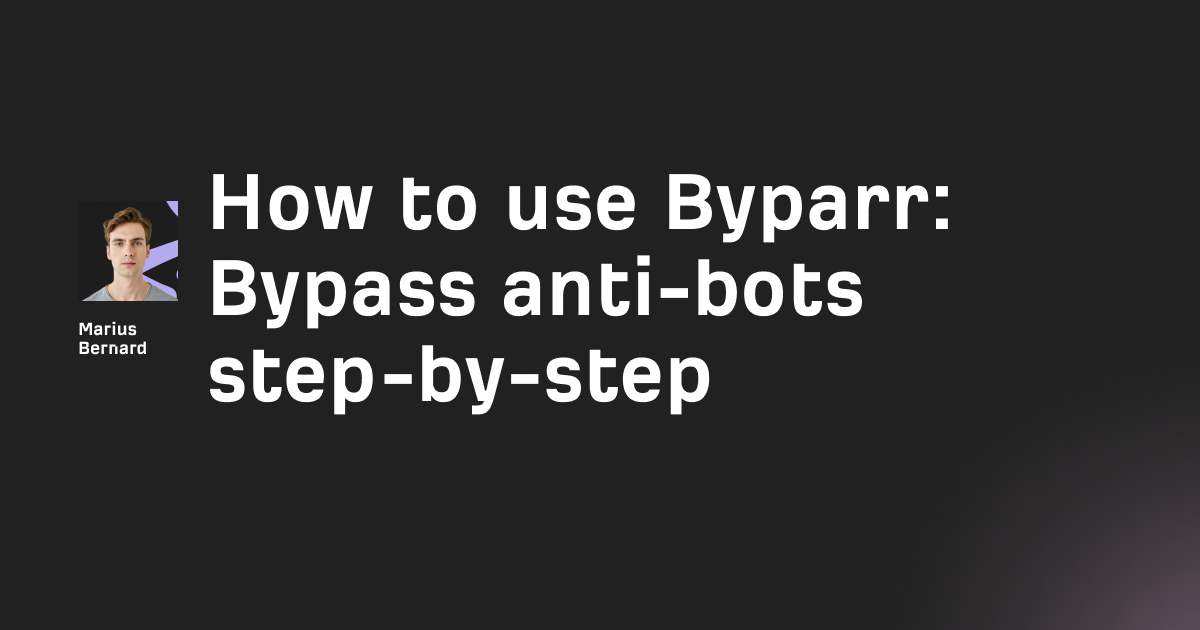cURL routes HTTP requests through your terminal using URL syntax. When you add proxies, you mask your real IP address and bypass network restrictions.
This guide shows you exactly how to configure curl with proxy servers for web scraping, API testing, and secure browsing.
What is cURL With a Proxy?
cURL with a proxy routes your requests through an intermediary server instead of connecting directly. The proxy server receives your request, forwards it to the destination, and returns the response. This approach hides your IP address and lets you bypass geo-restrictions while maintaining connection speeds 2-3x faster than VPNs.
You specify proxies using the -x flag or environment variables. The proxy intercepts all traffic before it reaches your target server.
Why Use Proxies With cURL?
Proxies solve three critical problems when making HTTP requests.
IP-based rate limiting gets bypassed because each request appears from a different address. Sites typically allow 100-200 requests per IP before blocking.
Geo-restricted content becomes accessible when you route through proxies in specific countries. Netflix, BBC iPlayer, and financial APIs all check request origin.
Corporate firewalls get circumvented since your traffic routes through an external server. Many organizations block direct access to certain domains.
Proxies also provide anonymity for security research, competitor analysis, and price monitoring without triggering anti-bot systems.
Installing cURL on Different Systems
Most systems include cURL by default. Check your installation first before downloading anything new.
macOS Installation
macOS ships with cURL pre-installed. Open Terminal and verify the version:
curl --version
You'll see version details, supported protocols, and available features. No installation needed.
Windows Installation
Windows 10 (version 1804+) includes cURL. However, PowerShell aliases curl to Invoke-WebRequest, which causes conflicts.
Use curl.exe instead of curl to access the actual cURL binary:
curl.exe --version
This bypasses the PowerShell alias and runs the real cURL command.
For older Windows versions, download the executable from curl.se/windows and add it to your PATH.
Linux Installation
Most Linux distributions include cURL. If not, install it using your package manager.
On Ubuntu/Debian:
sudo apt-get install curl
On Fedora/Red Hat:
sudo yum install curl
Verify installation with curl --version to confirm everything works.
Basic cURL Syntax Before Adding Proxies
Understanding basic cURL helps you troubleshoot proxy issues later. The simplest command fetches a URL and prints the response.
curl https://httpbin.org/ip
This returns your current IP address in JSON format. The response shows what destination servers see.
The -I flag fetches headers only:
curl -I https://example.com
You'll see status codes, content types, and server information without downloading the body.
Setting Up HTTP/HTTPS Proxies in cURL
The -x flag tells cURL to route requests through a proxy. This method works for all proxy types.
Using Command Line Arguments
The basic syntax follows this pattern:
curl -x [protocol://][username:password@]host:port URL
Here's a real example with an HTTP proxy:
curl -x http://proxy.example.com:8080 https://httpbin.org/ip
The response shows the proxy's IP address instead of yours. This confirms the proxy works correctly.
For HTTPS proxies, change the protocol:
curl -x https://proxy.example.com:8443 https://httpbin.org/ip
The longer --proxy flag does the same thing:
curl --proxy http://proxy.example.com:8080 https://httpbin.org/ip
Both flags work identically. Use whichever you find more readable.
Adding Proxy Authentication
Most premium proxies require username and password authentication. Include credentials in the proxy URL.
curl -x http://username:password@proxy.example.com:8080 https://httpbin.org/ip
The credentials get sent with every request. Proxies verify authentication before forwarding your traffic.
Alternatively, use the --proxy-user flag:
curl -x http://proxy.example.com:8080 --proxy-user username:password https://httpbin.org/ip
This separates credentials from the proxy URL for better readability.
For digest authentication, add the --proxy-digest flag:
curl -x http://proxy.example.com:8080 --proxy-user username:password --proxy-digest https://httpbin.org/ip
NTLM authentication uses --proxy-ntlm instead.
Configuring Proxies With Environment Variables
Environment variables let you set proxies globally without modifying each cURL command. This approach works best for consistent proxy usage.
Setting Variables on macOS/Linux
Export the http_proxy and https_proxy variables in your terminal:
export http_proxy="http://proxy.example.com:8080"
export https_proxy="http://proxy.example.com:8080"
Now every cURL command automatically routes through the specified proxy:
curl https://httpbin.org/ip
The response shows the proxy IP without using the -x flag.
To include authentication:
export http_proxy="http://username:password@proxy.example.com:8080"
export https_proxy="http://username:password@proxy.example.com:8080"
Unset variables to disable proxies:
unset http_proxy
unset https_proxy
Setting Variables on Windows
Windows PowerShell uses different syntax for environment variables:
$env:http_proxy = "http://proxy.example.com:8080"
$env:https_proxy = "http://proxy.example.com:8080"
Clear variables with empty strings:
$env:http_proxy = ""
$env:https_proxy = ""
Use curl.exe instead of curl to avoid the PowerShell alias.
Using the ALL_PROXY Variable
The ALL_PROXY variable works for all protocols:
export ALL_PROXY="http://proxy.example.com:8080"
Protocol-specific variables like http_proxy override ALL_PROXY when both exist.
Creating a Permanent Proxy Configuration File
The .curlrc file stores default cURL options. This eliminates repetitive proxy specifications in every command.
Linux and macOS Configuration
Navigate to your home directory:
cd ~
Create or edit the .curlrc file:
nano .curlrc
Add the proxy configuration:
proxy = "http://proxy.example.com:8080"
proxy-user = "username:password"
Save the file and exit. cURL now automatically uses these settings.
Test it without specifying a proxy:
curl https://httpbin.org/ip
The response shows the proxy IP, confirming the configuration works.
Windows Configuration
Windows uses _curlrc (with an underscore) instead of .curlrc.
Find your %APPDATA% directory:
echo %APPDATA%
This typically resolves to C:\Users\<YourUsername>\AppData\Roaming.
Navigate there in File Explorer and create _curlrc with the same content:
proxy = "http://proxy.example.com:8080"
proxy-user = "username:password"
cURL loads this file automatically on Windows.
Using SOCKS Proxies With cURL
SOCKS proxies handle more than just HTTP traffic. They support any protocol, making them more versatile.
SOCKS4 Proxies
Specify the socks4:// protocol:
curl -x socks4://proxy.example.com:1080 https://httpbin.org/ip
SOCKS4 doesn't support authentication or IPv6. It's an older protocol with limited features.
SOCKS5 Proxies
SOCKS5 adds authentication and IPv6 support:
curl -x socks5://username:password@proxy.example.com:1080 https://httpbin.org/ip
Use socks5h:// to make the proxy resolve DNS queries:
curl -x socks5h://proxy.example.com:1080 https://httpbin.org/ip
This prevents DNS leaks by forcing resolution through the proxy.
Alternative SOCKS Syntax
The --socks5 flag provides another way to specify SOCKS proxies:
curl --socks5 proxy.example.com:1080 https://httpbin.org/ip
Add authentication separately:
curl --socks5 proxy.example.com:1080 --proxy-user username:password https://httpbin.org/ip
This syntax separates the proxy address from credentials.
Bypassing Proxies for Specific Domains
Sometimes you need to exclude certain domains from proxy routing. The --noproxy flag handles this.
Excluding Single Domains
Bypass the proxy for specific hosts:
curl --noproxy "example.com" https://example.com
This makes a direct connection instead of routing through the proxy.
Excluding Multiple Domains
Use comma-separated lists:
curl --noproxy "localhost,127.0.0.1,example.com" https://example.com
Local addresses should always bypass proxies to avoid unnecessary routing.
Excluding All Domains
Use an asterisk to disable proxies entirely:
curl --noproxy "*" https://httpbin.org/ip
This overrides any global proxy settings for a single request.
Using the NO_PROXY Environment Variable
Set NO_PROXY to permanently exclude domains:
export NO_PROXY="localhost,127.0.0.1,.example.com"
Domains starting with a dot match all subdomains. The pattern .example.com matches both www.example.com and api.example.com.
Since cURL 7.86.0, you can use CIDR notation:
export NO_PROXY="192.168.0.0/16"
This excludes an entire IP network.
Rotating Proxies for Large-Scale Scraping
Rotating proxies prevent IP bans during high-volume requests. Most scraping projects need proxy rotation.
Manual Rotation With Shell Scripts
Create a script that randomly selects proxies:
#!/bin/bash
proxies=("http://proxy1.example.com:8080" "http://proxy2.example.com:8080" "http://proxy3.example.com:8080")
proxy=${proxies[$RANDOM % ${#proxies[@]}]}
curl -x $proxy https://httpbin.org/ip
Each execution uses a different proxy from the array.
Save this as rotate_proxy.sh and make it executable:
chmod +x rotate_proxy.sh
Run it multiple times to see different proxy IPs:
./rotate_proxy.sh
Using Proxy Services With Automatic Rotation
Premium proxy providers offer automatic rotation. You connect to a single endpoint that rotates IPs.
curl -x http://username:password@rotating.example.com:8080 https://httpbin.org/ip
Each request gets a new IP without manual intervention. Services like Bright Data and Oxylabs provide this feature.
Rotating residential proxies cost more but avoid detection better than datacenter IPs.
Advanced Proxy Techniques and Optimization
These advanced methods improve performance and reliability when using curl with proxy servers.
Creating Proxy Aliases for Quick Switching
Add aliases to your .bashrc file:
alias proxyon="export http_proxy='http://proxy.example.com:8080';export https_proxy='http://proxy.example.com:8080'"
alias proxyoff="unset http_proxy;unset https_proxy"
Reload your shell:
source ~/.bashrc
Now toggle proxies with simple commands:
proxyon
curl https://httpbin.org/ip
proxyoff
This eliminates typing long proxy URLs repeatedly.
Enabling Connection Reuse
The --keepalive-time flag maintains connections:
curl -x http://proxy.example.com:8080 --keepalive-time 60 https://example.com
Reusing connections reduces overhead by 40-60% for multiple requests.
Enabling Compression
Request compressed content to save bandwidth:
curl -x http://proxy.example.com:8080 --compressed https://example.com
Servers send gzipped responses when you enable compression. This speeds up transfers through slow proxies.
Using Verbose Mode for Debugging
The -v flag shows everything happening:
curl -v -x http://proxy.example.com:8080 https://httpbin.org/ip
You'll see proxy connection details, TLS handshakes, headers sent, and headers received.
This helps diagnose authentication failures, connection timeouts, and SSL errors.
Troubleshooting Common Proxy Errors
Understanding error messages saves hours of debugging time.
Connection Refused Errors
Error: curl: (7) Failed to connect to proxy.example.com port 8080: Connection refused
Cause: The proxy server isn't running or blocks connections.
Fix: Verify the proxy address and port. Check firewall rules blocking outbound connections.
Proxy Authentication Failures
Error: curl: (407) Proxy Authentication Required
Cause: Missing or incorrect credentials.
Fix: Double-check your username and password. Some proxies require URL encoding for special characters.
SSL Certificate Errors
Error: curl: (60) SSL certificate problem: unable to get local issuer certificate
Cause: The proxy uses a self-signed certificate or your system doesn't trust it.
Fix: Use the -k flag to bypass certificate verification:
curl -k -x https://proxy.example.com:8443 https://httpbin.org/ip
Never use -k in production. Install the proxy's certificate instead.
Timeout Errors
Error: curl: (28) Connection timed out after 300000 milliseconds
Cause: Slow proxies or network issues.
Fix: Increase the timeout:
curl -x http://proxy.example.com:8080 --connect-timeout 60 https://httpbin.org/ip
Or try a different proxy with better latency.
DNS Resolution Failures
Error: curl: (6) Could not resolve host: proxy.example.com
Cause: The proxy hostname doesn't exist or DNS isn't working.
Fix: Use the proxy's IP address instead:
curl -x http://203.0.113.10:8080 https://httpbin.org/ip
Or check your DNS settings.
Comparing Proxy Types for cURL
Different proxies serve different purposes. Choose based on your requirements.
HTTP Proxies
Speed: Fastest option with minimal overhead.
Use Cases: Simple web requests, API calls, testing.
Limitations: No encryption. Destination servers see unencrypted traffic.
Best for internal testing and development environments.
HTTPS Proxies
Speed: Slightly slower due to encryption overhead.
Use Cases: Secure API calls, handling sensitive data.
Limitations: More complex setup with certificate management.
Choose HTTPS proxies when security matters more than speed.
SOCKS5 Proxies
Speed: Moderate. Handles any protocol, not just HTTP.
Use Cases: Complex applications, bypassing deep packet inspection.
Limitations: More configuration required. Not all servers support SOCKS.
SOCKS5 works best when you need protocol flexibility.
Residential vs Datacenter Proxies
Residential proxies use real device IPs. They cost more but avoid detection.
Datacenter proxies come from servers. They're faster and cheaper but easier to block.
For web scraping at scale, residential proxies worth the extra cost.
Security Best Practices for Proxy Usage
Proxies introduce security risks if not configured properly.
Never Use Free Public Proxies
Free proxies log your traffic, inject ads, and steal credentials. They're unreliable and often run by malicious actors.
Free proxy lists on GitHub and proxy sites typically contain compromised servers.
Store Credentials Securely
Don't hardcode passwords in scripts. Use environment variables:
export PROXY_USER="username"
export PROXY_PASS="password"
curl -x http://$PROXY_USER:$PROXY_PASS@proxy.example.com:8080 https://httpbin.org/ip
Or use a credential manager like pass or 1Password.
Verify SSL Certificates
Always validate certificates in production:
curl -x https://proxy.example.com:8443 https://httpbin.org/ip
Using -k disables critical security checks. Only bypass certificates during local testing.
Monitor Proxy Performance
Track response times to detect slow proxies:
curl -x http://proxy.example.com:8080 -w "@curl-format.txt" -o /dev/null -s https://httpbin.org/ip
Create curl-format.txt:
time_namelookup: %{time_namelookup}\n
time_connect: %{time_connect}\n
time_total: %{time_total}\n
This shows DNS lookup, connection, and total time.
Real-World Use Cases Beyond Web Scraping
Proxies solve problems across different domains.
Testing Geo-Restricted APIs
Financial APIs often restrict access by country. Route through proxies in allowed regions:
curl -x http://uk-proxy.example.com:8080 https://api.ftse.com/data
This lets you test UK-only endpoints from anywhere.
Bypassing Corporate Firewalls
Many companies block direct API access. Proxies route around these restrictions:
curl -x http://external-proxy.com:8080 https://blocked-api.com/endpoint
Check your company's policies before using external proxies for work.
Monitoring Competitors
Track competitor pricing without revealing your identity:
curl -x http://residential-proxy.example.com:8080 https://competitor.com/products
Residential proxies prevent detection better than datacenter IPs.
SEO Research and SERP Scraping
Search engines show different results by location. Test rankings globally:
curl -x http://germany-proxy.example.com:8080 "https://www.google.de/search?q=test+query"
This reveals how your site ranks in different countries.
API Rate Limit Distribution
Distribute requests across multiple IPs to avoid hitting rate limits:
for proxy in "${proxies[@]}"; do
curl -x "$proxy" https://api.example.com/endpoint
done
Each request appears from a different source.
Performance Comparison: Direct vs Proxy Connections
Understanding performance trade-offs helps set realistic expectations.
Direct Connection: 50-100ms typical latency.
HTTP Proxy: 80-150ms (+30-50ms overhead).
Residential Proxy: 200-500ms (slower but more reliable).
Free Proxy: 1000-5000ms (avoid in production).
Proxies add latency but provide benefits that outweigh the speed cost.
Connection reuse and compression reduce the overhead significantly. Enable both for production workloads.
Choosing the Right Proxy Provider
Quality varies dramatically between providers.
Roundproxies: Largest network, budget-friendly.
ScrapingBee/ScrapFly: Developer-friendly, built-in anti-bot bypass.
Avoid providers without clear pricing, documentation, or support channels.
Conclusion
Using curl with a proxy masks your IP address and bypasses network restrictions effectively. The -x flag provides the simplest setup method.
Environment variables work best for consistent proxy usage across multiple requests. Configuration files eliminate repetitive typing.
Choose proxy types based on your security needs. HTTPS proxies protect sensitive data while SOCKS5 handles any protocol.
Rotating proxies prevents IP bans during large-scale scraping. Premium providers offer automatic rotation for easier implementation.
Always validate certificates in production. Never use free proxies for real projects.
Start with HTTP proxies for testing. Upgrade to residential proxies when detection becomes an issue.
Frequently Asked Questions
What's the default proxy port in cURL?
cURL uses port 1080 by default when you don't specify a port. HTTP proxies typically use port 8080 or 3128.
Can I use multiple proxies simultaneously?
No. cURL routes through one proxy per request. Rotate proxies manually or use a rotating proxy service.
Do proxies slow down requests significantly?
Quality proxies add 30-50ms latency. Free proxies add 1-5 seconds or fail completely.
How do I test if my proxy works?
Visit httpbin.org/ip through your proxy. The response shows your proxy's IP if configured correctly.
What's the difference between -x and --proxy?
They're identical. --proxy is the long form of -x. Both flags work exactly the same way.








